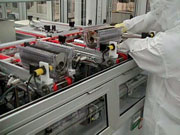
Just when it seems that manufacturers could soon print bar codes on those cartons, pieces of equipment, etc., that don't already have them, a new technology will replace many "zebra stripes." This next new thing provides many more benefits than bar codes, even the new longer bar codes. And it isn't impacted by conditions that sometimes make bar codes unreadable. But it has some drawbacks that are keeping it from being widely adapted in the near future. Yet the day when it's as widely used as bar codes just came closer when a consumer products manufacturer, Gillette, ordered 500,000,000 (that's right, 500 million) of them for trial use in its supply chain.
RFID
RFID (for radio-frequency identification) involves a computer memory chip that is embedded in or attached to a box, piece of equipment, pallet, etc.; or embedded in a self-adhesive bar code label (providing human-readable and electronic data). For example, a chip can be molded into a plastic whirlpool or attached inside an air-conditioning unit. The chip, or "smart label," can store much more than the item's code number because it can store an electronic product code (EPC). The EPC can be about 100 "bits" long, which can represent hundreds of millions of different manufacturer-item combinations. And an EPC can store unit- or carton-specific data such as date of manufacture, plant ID, manufacturer's Web site address, lot or serial number, etc.(People who keep up with leading edge technology know that RFID is already being used by some manufacturers and some European wholesalers to track products during manufacturing and/or conveyor routing. These RFID chips continuously transmit data until their batteries wear out, and are very expensive -- $1.50 or more per. This article addresses chips that don't broadcast and are much, much cheaper).
Wireless devices similar to bar code readers (and of equal cost) read the stored data by sending a signal to a chip, which then transmits the data (via its antenna). The data is then transmitted by the "reader" to the computer system linked to all the readers in the warehouse. As with bar codes, data from smart labels can be checked for validity, and errors detected early on. RFID readers and related equipment are already on the market.

Updatable Data
Unlike a printed bar code, an RFID chip can do much more than store data placed in it by a manufacturer. A "read/write" type of RFID chip can store data that is added by each person who handles the box, carton, unit, etc. For example, the date an item was received and the bin location where it was initially placed can be recorded in its label; the date it was picked for delivery and the ID of the customer to whom it was sold can also be recorded. Read/write RFID chips allow tracking items at every stage of the supply chain.Users who are allowed to add data must use special "read/write" devices. Authorized and equipped users can even erase all the stored data, and then store brand new data (such as a new item code, date of receipt, etc.); something not possible with bar codes. When reading, read/write devices check for validity just as read-only devices do. RFID read/write devices, encoders, printer-encoders (for bar code labels with embedded RFID) and related equipment are already on the market.
Wholesalers who are too anxious to wait for manufacturers to use RFID can buy read/write chips (and equipment) and do their own encoding (like printing their own bar code labels).
Help, I'm Running Low!
Even if each smart label has an antenna, low-cost smart labels cannot broadcast the fact that the quantity on hand is running low. But, special label readers placed on shelves could be programmed to regularly read nearby labels and transmit data about the quantity of each item to the company's system. Software in the system would compare the item's level to its re-order point or minimum stocking quantity, and when needed, alert someone that it may be time to re-order. For wholesalers using VMI, the manufacturer could be directly alerted, via the Net, that it's time to ship more.Big Benefits
Because memory chip reading devices are radio transceivers, users don't need a direct line of sight to read a smart label, nor do they have to wait for an item or box to stop moving before reading. They wouldn't spend as much time as they now do reading bar codes. And, smart label readers can read several labels at about the same time, greatly reducing the time for tasks like put-away-location recording, cycle counting and taking physical inventory. Wholesalers who must record serial numbers of items sold can save time there, too, because the reading process eliminates the need to manually read and then key in or transcribe serial numbers. The overall impact is to reduce the amount of labor required, which in turn could reduce the number of personnel needed in a warehouse.When being read, smart labels aren't subject to nearly as many errors as bar codes. This improves customer service and reduces the cost of handling returns.
Smart labels can withstand high temperatures and humidity, and are unaffected by dust, dirt, spills, etc. -- conditions which have made many a bar code label unreadable (and also made the printed descriptions and codes unreadable by people).
The updatable-data feature of RFID chips means that stored data can be "real time," which helps partners in a supply chain relationship reduce pipeline inventory, provide for faster response to sudden dramatic changes in sales, decrease stock outs, and improve forecasting.
Remember the manufacturer's Web site address mentioned in the description of data that could be stored in a smart label? Now envision software that reads the address from a smart label, accesses the manufacturer's Web site, and uses the item code to access and display the latest specs about that item. Such a capability would save time, avoid having to handle and store lots of printed specs (that often are outdated), and reduce the cost of returns of out-of-spec items that are accidentally shipped.
Unlike a printed bar code, a smart label can be used over and over simply by erasing all the stored data and writing new data. This reduces the cost advantage that bar codes now have.
For wholesalers with self-service displays, or with worries about theft in general, smart labels can reduce such losses. When an item is checked out at the front counter, or staged for loading on a truck, a code can be stored in its smart label to indicate that it has been billed or paid for; sensors at doors would sound an alert if they detected items where the smart label didn't have the "ok" indicator.
Drawbacks
As with any new technology, the biggest immediate drawback is cost. In moderate volumes, the cost of each smart label is now on the order of 10 to 15 cents, but in high volumes (like those mentioned in the first paragraph), the cost should come down to about 5 cents. That's a lot more than a printed bar code, but cost-justified for many of the items handled by a typical supply house, although for low-value commodity items, even 5 cents may never be justified.The cost of smart label reading devices is not much more than the cost of high-performance bar code readers, which are expensive. But the cost of devices that update as well as read is a notch higher. And since RFID is not likely to replace all bar codes, the co-existence of bar codes and RFID will present another cost challenge to distributors who must buy and maintain new, expensive equipment for RFID (or RFID and bar codes together).
Electromagnetic interference from computer devices, especially wireless ones, and some lighting fixtures can be another problem. Preventing such interference could be prohibitively expensive -- imagine the cost of replacing all the discharge-type lighting in the warehouse. Worse, the data on unshielded memory chips could be damaged or destroyed as they pass through trucks, planes, freight terminals, airports, airport security devices, etc.
Another problem common to new technology is that there are no standards for encoding patterns, nor for which frequencies to use when reading and writing. Different brands of readers/writers can perform very differently from each other.
Another technical and cost challenge is that wholesalers have to modify their business software to verify the new kinds of data read from smart labels, and to store it (in databases). They also need to modify software so it can add data to read/write labels.
Due to cost and other reasons, RFID may never replace all bar codes, but it should make a big dent in much of distribution, especially where the frequent updating of information is worth the cost.

